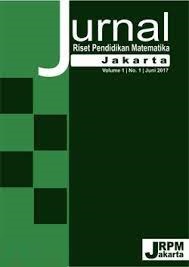Analisis Tingkat Berpikir Siswa Berdasarkan Teori Van Hiele Materi Segi Empat dan Segitiga Ditinjau dari Gaya Kognitif
DOI:
https://doi.org/10.21009/jrpmj.v4i1.25723Keywords:
cognitive styles, quadrilaterals, triangles, Van Hiele theory, student’s thingking levelsAbstract
This study aims to describe students' thinking levels based on Van Hiele's theory on quadrilaterals and triangles material in terms of reflective and impulsive cognitive styles. The research method used is descriptive qualitative. The subjects in this study were students of class VIII H SMP Negeri 1 Wanasaba. The instruments used are cognitive style tests, geometry tests, and interviews. The results showed that the cognitive style of students in class VIII H of SMP Negeri 1 Wanasaba was generally dominated by students with reflective and impulsive cognitive styles, 71.9% greater than students with fast accurate and slow inaccurate cognitive styles, namely 28.1%. Students with reflective cognitive style are generally at the analysis level (level 1). Reflektive students are able to identify the shapes of quadrilaterals and triangles, are able to determine the names of a quadrilateral and triangular shapes, are able to determine the properties and similarities of the properties. Students with impulsive cognitive style are generally at the visualization level (level 0). Impulsive student at this level are able to identify rectangular and triangular and are able to determine the names of flat shapes correctly but not yet complete.
References
Aiken, L. R. (1985). Three Coefficients for Analyzing The Reliability and Validity of Ratings. Educational and Psychological Measurement: SAGE Journals, 45(1), 131–142.
Ain, H., Baidowi, & Hapipi. (2020). Kemampuan Siswa dalam Pemecahan Masalah Geometri Berdasarkan Tingkat Berpikir Van Hiele. Jurnal Pijar MIPA, 15(3), 273–279.
Anwar, A. (2019). Perbedaan Hasil Belajar Matematika Siswa Ditinjau dari Level Geometri Van Hiele SMP kelas VII. Mandalika Mathematics and Education Journal, 1(2), 74–80.
Azhil, I. M., Ernawati, A., & Lutfianto, M. (2017). Profil Pemecahan Masalah Matematika Siswa Ditinjau dari Gaya Kognitif Reflektif dan Impulsif. Jurnal Review Pembelajaran Matematika, 2(1), 60–68.
Desmita. (2009). Psikologi Perkembangan Peserta Didik. Bandung: PT Remaja Rosdakarya.
Ilhamuddin, Ridwan, M., & M, M. D. (2021). Deskripsi Pemahaman Konsep dalam Menyelesaikan Soal Teorema Phytagoras Ditinjau dari Gaya Kognitif pada Siswa Kelas VIII SMP Negeri 3 Camba. Infinity: Jurnal Matematika Dan Aplikasinya (IJMA), 2(1), 40–50.
Indah, N., Prayitno, S., Amrullah, & Baidowi. (2021). Analisis Kemampuan Pemecahan Masalah Matematika pada Materi Pola Bilangan Ditinjau dari Gaya Kognitif Reflektif-Impulsif. Griya Journal of Mathematics Education and Application, 1(2), 106–114.
Intan, R., Sahara, A., & Nurfauziah, P. (2021). Analisis Kesulitan Siswa Materi Bangun Ruang Sisi Datar Berdasarkan Tahap Berpikir Van Hiele. Jurnal Pembelajaran Matematika Inovatif, 4(4), 911–920.
Junaedi, B. (2017). Penerapan Teori Belajar Van Hiele pada Materi Geometri Di Kelas VIII. MES (Journal of Mathematics Education and Science), 3(1), 1–7.
Kagan, J. (1965). Impulsive and reflective children: Significance of conceptual tempo. Dalam Krumboltz, J.D (Eds.) Learning and the Educational Process, 1(1), 133–161.
Kagan, J., & Kogan, N. (1970). Individual variation in cognitive process. Dalam Mussan, P. (Edt.) Carmichael’s Manual of Child Psychology (3rd Ed. Vol. 1) Wiley New York., 1(1).
Mahfiroh, N., Mustangin, & Wulandari, T. C. (2021). Kemampuan Pemecahan Masalah Matematis Ditinjau dari Gaya Kognitif. LAPLACE: Jurnal Pendidikan Matematika, 4(1), 63–74.
Moleong, L. J. (2014). Metodologi Penelitian Kualitatif. Bandung: PT Remaja Rosdakarya.
Nasriadi, A. (2016). Berpikir Reflektif Siswa SMP dalam Memecahkan Masalah Matematika Ditinjau dari Perbedaan Gaya Kognitif. E-Journal STKIP BBG, III(1), 15–26.
Pertiwi, M., & Sudihartinih, E. (2020). Analisis Kemampuan Berpikir Geometri Van Hiele Siswa Sekolah Menengah Pertama Ditinjau dari Perspektif Gender. PYTHAGORAS: Jurnal Program Studi Pendidkan Matematika, 9(2), 86–94.
Petrus, Z., Karmila, & Riady, A. (2017). Deskripsi Kemampuan Geometri Siswa SMP Berdasarkan Teori Van Hiele. Pedagogy: Jurnal Pendidikan Matematika, 2(1), 145–160.
Razak, F., & Sutrisno, A. B. (2017). Analisis Tingkat Berpikir Siswa Berdasarkan Teori Van Hiele pada Materi Dimensi Tiga Ditinjau dari Gaya Kognitif Field Dependent. Edumatica, 07(02), 22–29.
Rozencwajg, P., & Corroyer, D. (2005). Cognitive Processes In The Reflective – Impulsive Cognitive Style. The Journal of Genetic Psychology, 166(4), 451–463.
Sa’o, S., Naja, F. Y., & Mei, A. (2020). Tingkat Berpikir Geometri Van Hiele Ditinjau dari Perbedaan Gender dan Kemampuan Matematika. Jurnal Dedikasi Pendidikan, 4(2), 171–182.
Saifuddin, A. (2020). Penyusunan Skala Psikologi. Jakarta: KENCANA.
Sholihah, S. Z., & Afriansyah, E. A. (2017). Analisis Kesulitan Siswa dalam Proses Pemecahan Masalah Geometri Berdasarkan Tahapan Berpikir Van Hiele. Jurnal Mosharafa, 6(2), 287–298.
Suherman, E. (2003). Strategi Pembelajaran Matematika Kontemporer. Bandung: Universitas Pendidikan Indonesia.
Usiskin, Z. (1982). Van Hiele Levels and Achievement In Secondary School Geometry. Chicago: The University of Chicago.
Van de Walle, J. A. (2001). Chapter 17 Geometric Thinking and Geometric Concepts. In Elementary and Middle School Mathematics: Teaching Developmentally (4th editio, pp. 306–312). Pearson Education.
Warli. (2013). Kreativitas Siswa SMP yang Bergaya Kognitif Reflektif atau Impulsif dalam Memecahkan Masalah Geometri. Jurnal Pendidikan Dan Pembelajaran, 20(2), 190–201.
Yudianto, E., Nindya, Y. S., & Setiawan, T. B. (2021). Kecemasan Geometri Siswa dalam Menyelesaikan Masalah Bangun Ruang Sisi Datar Ditinjau dari Teori Van Hiele. Jurnal Cendikia: Jurnal Pendidikan Matematika, 05(02), 1102–1115.




